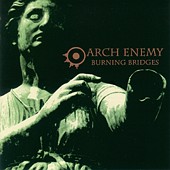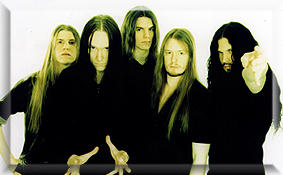|
|
|
|

Yet to label this a Stigmata, Part 2 would be a misnomer, for the band has honed its successful formula in ways that propel this release beyond anything in the band's catalog, due, in great part, to a more fist-in-the-face song structure. Sure, the guitars of the brothers Amott still rule the mix, partaking in the twin leads and digressive solo noodlings that have become the band's trademark. Yet now the music seems driven by - gasp! - an even greater immediacy, a more streamlined thrashiness that carries the band from Point A to Point B much more economically.
Also bolstering the twin axe attack is the increased influence of "classic metal." One listen to "Pilgrim" will reveal some creative copying from Blue Oyster Cult's "Astronomy," and the opening bars of "Seed of Hate" sound remarkably like a turbo charged version of Ozzy Osbourne's "Bark at the Moon." This is not to dub the fellows rip-off artists, but merely students and fans of metal who are increasingly incorporating their disparate influences into the fray without isolating fan expectations. Besides, any hang ups you have concerning strikingly similar riffs to those of our heavy metal forefathers should be obliterated by tunes such as "Silverwing," perhaps my all time favorite song the band has crafted, and "Angel Claw," with it's "Ronnie-James-Dio-Evil-Woman-Look-Out- Tonight" vibe.
The greatest strides made, however, lie in the vocal stylings of Johan Liiva, who has damn near abandoned the annoyingly gruff leanings of Stigmata for a more accessible approach that compliments the melodic intricacies of the music much more effectively. Oddly enough, only once does he slip back into the Johan of old, on the album's closer, "Burning Bridges," which seems the least likely song on the album on which to regress, with its brooding sadness accentuated by a first for the band, the addition of a mellotron into the mix. Perhaps the quirkiest fact about the tune, however, is not the introduction of a very uncharacteristic instrument within metal circles, but that the vocals still don't stain the eerie beauty of the song.
The only chink I see in the armor of the band this go around concerns the flow of the music itself. Quite often, the changes in rhythm are so abrupt that it appears as if the album's producer is involved in some very subpar patchwork, gluing together a collage where the pieces don't exactly fit. Well, not smoothly, anyway. I prefer the bleeding segue, a blending that unites two elements without the obvious and force-fed juxtaposition, performed much more to my tastes on Stigmata.
Regardless, Burning
Bridges suffers little. So little, in fact, that I am compelled
to ask, "Does anyone do melodic death metal better than Arch Enemy?"
At this point in time, I don't believe so.

Yet there is a flipside to this brotherly and sisterly love vibe, and it is the oh so common sibling rivalry. Perhaps it affects all who share in a relationship as intimate as that between brothers or sisters, but I must admit that I have never overheard any juicy stories of bad blood between the aforementioned two pairs of brothers - no, Eddie has never swung his axe at Alex's glaring mug, and Vinnie Paul has never tugged the hell out of Dimebag's hot pink goatee during a jam session gone awry. If this is true, perhaps these anomalies can be explained by the fact that no one in these cases plays the same instrument as his significant other, thus relieving any compounded tension by eliminating the obsessive drive for innerfamily competition.
But what can be said of Michael and Christopher Amott, two brothers who just so happen to be members of the same band? And play the same instrument? Should we expect a musical Armageddon, two excessive egos jousting for six-string spotlight in the cramped confines of a 45 minute compact disc? A musical affair marred by an annoying desire to outshine the other, thus creating a special siblings addition of Celebrity Death Match?
Fortunately, it doesn't work that way. Maybe this has much to do with the different approaches each brings to playing the guitar: the younger Chris is heavily steeped in musical theory, even spending time in music school, while the older Mike is renowned for his straight ahead, brutally hard riffing - after all, he was in Carcass. Whether or not this is an adequate explanation, it doesn't negate the fact that you will be hard pressed to find a more fluid and innovative guitar tandem at work in metal. Take the songs, for example. During the course of a single tune, the music effortlessly slides from a hard, chugging grind only to shift in a blastbeat's lifespan to a beautiful harmonic melody. A great example of this is in the album's opener, "Beast of Man," which begins with some of the heaviest riffs on the album. At the chorus, however, an Iron Maidenesque dual harmony kicks in beneath the grating voice of lead barker Johan Liiva. And this is the Arch Enemy formula, brutal riffing juxtaposed and interjected with mellow interludes, such as in the album's two instrumentals, the title track and "Vox Stellarum," the smooth break in "Let the Killing Begin," or the beautiful coda that closes the album on "Bridge of Destiny."
If there is a chink in the armor of the band, however, it is the aforementioned Liiva, whose monotonous, "Barney" Greenway of Napalm Death bark grows tiresome and ultimately clashes with the music. Yet death metal, regardless of how melodic or technical its origins, has never been known for the finesse of its vocalists, so I would not allow this to deter you from this excellent cd. It is my hope that future releases by the band will reflect some growth on Liiva's part, complementing the complexity of the music with a more varied approach to his vocal responsibilities.
The great thing about
this album is the great thing about the Amott brothers - since they aren't
caught up in kicking each other's asses, they have more time to kick ours.
And that they do.

